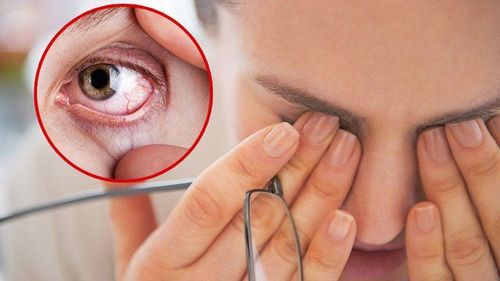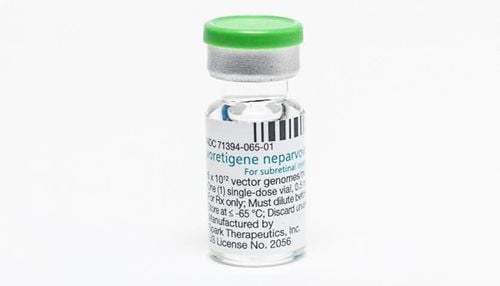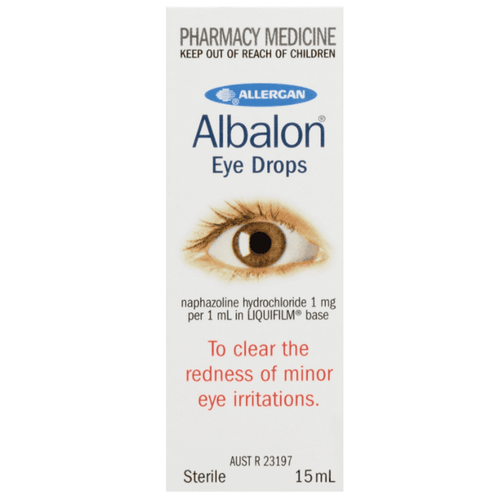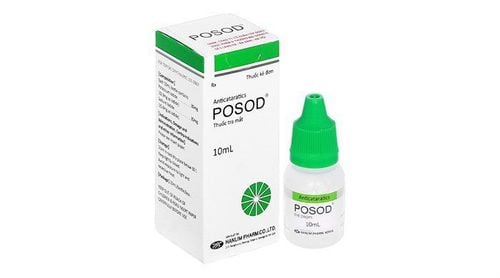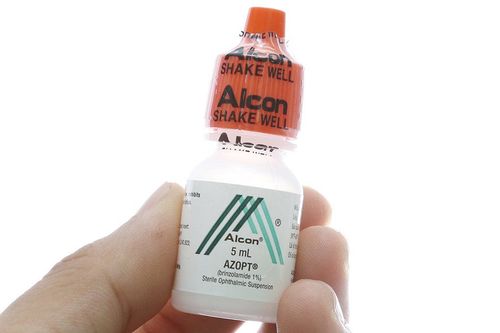This is an automatically translated article.
The article was professionally consulted by Specialist Doctor I Nguyen Thi Bich Nhi - Ophthalmologist - General Surgery Department - Vinmec Nha Trang International General Hospital.Can you hardly see distant objects, like highway signs, until you are a few feet away, but easily read a book up close? Chances are you are nearsighted. This is a fairly common condition, often indicated by eyeglasses, contact lenses, or eye surgery.
1. Causes of myopia
The cause of myopia is that the eyeball axis is too long, related to the focusing power of the cornea and the crystalline lens of the eye, causing light rays instead of entering the retina to focus at a point in front of the retina. . In addition, the disease can also occur because the cornea or lens is too curved compared to the eyeball. In some cases, myopia occurs due to a combination of the above causes.Myopia usually begins at an early age and children whose parents are nearsighted are at increased risk of developing myopia. Usually, the disease becomes less severe in adulthood. However, there are still cases that continue to progress with age.
High myopia: This is a severe form of myopia in which the eyeballs grow more than normal. In addition to making it difficult to see things at a distance, high myopia can also make you more likely to get other diseases like retinopathy, cataracts, and glaucoma. Degenerative myopia: also known as pathological myopia, this condition is very rare and it is inherited. The eyeballs of people with myopia degenerate very quickly and cause severe myopia. Degenerative myopia usually occurs in adolescence. This type of myopia can get worse as you reach adulthood. Besides making it difficult for you to see things at a distance, you may also have a higher risk of retinal detachment, the growth of abnormal blood vessels in the eye (choroidal neovascularization), and disease. increased intraocular pressure.

Có nhiều nguyên nhân khác nhau gây ra cận thị hiện nay
2. Signs of myopia
Here are some common signs in people who are nearsighted:Difficulty seeing distant objects Headache Or squinting Eyes fatigue Eye pain when trying to see objects more than a few feet away Children are nearsighted often have difficulty reading at the blackboard
3. Diagnosis
Myopia is diagnosed with a basic eye exam, which includes a refractive evaluation and an eye exam.Refractive assessment helps determine if you have vision problems such as nearsightedness or farsightedness, astigmatism. The therapist uses different instruments and asks you to look through several lenses to check your distance and near vision.
To check your eye health, your doctor will put a few drops of eye drops in your eyes to dilate your pupils. This can make your eyes more sensitive for several hours after the eye exam is done. The dilation allows the doctor to see a wider view of the inside of your eye.
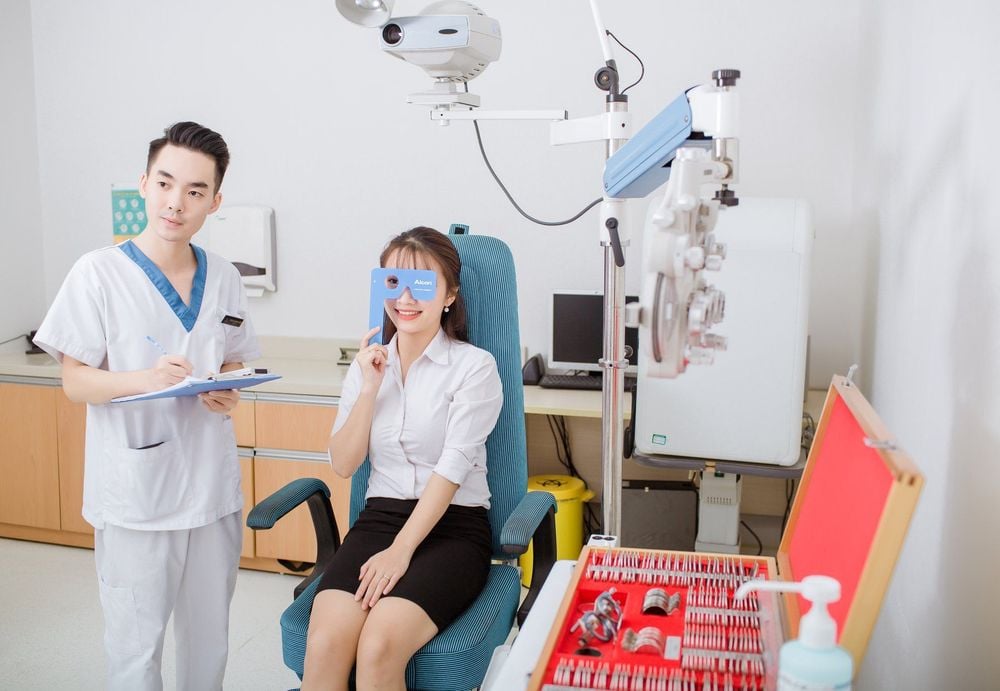
Cận thị cần được chẩn đoán chính xác thông qua khám mắt
4. Myopia treatment
The goal of nearsightedness treatment is to improve vision by helping to focus light onto your retina through the use of corrective lenses or refractive surgery. Management of myopia also includes regular monitoring for complications of this condition, including glaucoma, cataracts, lacrimation and retinal detachment, and damage to the central retina.Myopia can be cured with refractive surgery, but children under 18 are not old enough to have surgery. Therefore, wearing glasses is the most optimal treatment for nearsightedness.
Several treatments for myopia, including:
Wearing glasses to correct myopia
Wear glasses to correct myopia to correct the curvature of your cornea or increase the length of your eyes. Prescribed lenses include:
Eyeglasses: This is a simple, safe way to correct nearsightedness. Eyeglasses can correct some vision problems such as nearsightedness and astigmatism. This is the most economical solution. Contact lenses: These lenses are worn right over your eyes. There are many types of contact lenses available in the market, in soft, hard materials, with spherical, toroidal and omnidirectional designs. Talk to your doctor about the pros and cons of contact lenses and the best treatment for you. Refractive surgery
Refractive surgery reduces the need for eyeglasses and contact lenses. An eye surgeon uses a laser beam to reshape the cornea. Even after surgery, you may need to wear eyeglasses for a period of time.
Laser-assisted keratomileusis in situ (LASIK): With this technique, the eye surgeon creates a thin, hinged flap into the cornea. A laser is then used to remove the inner layers of the cornea to flatten its dome shape. Recovery from LASIK surgery is usually quicker and causes less discomfort than other corneal surgeries.
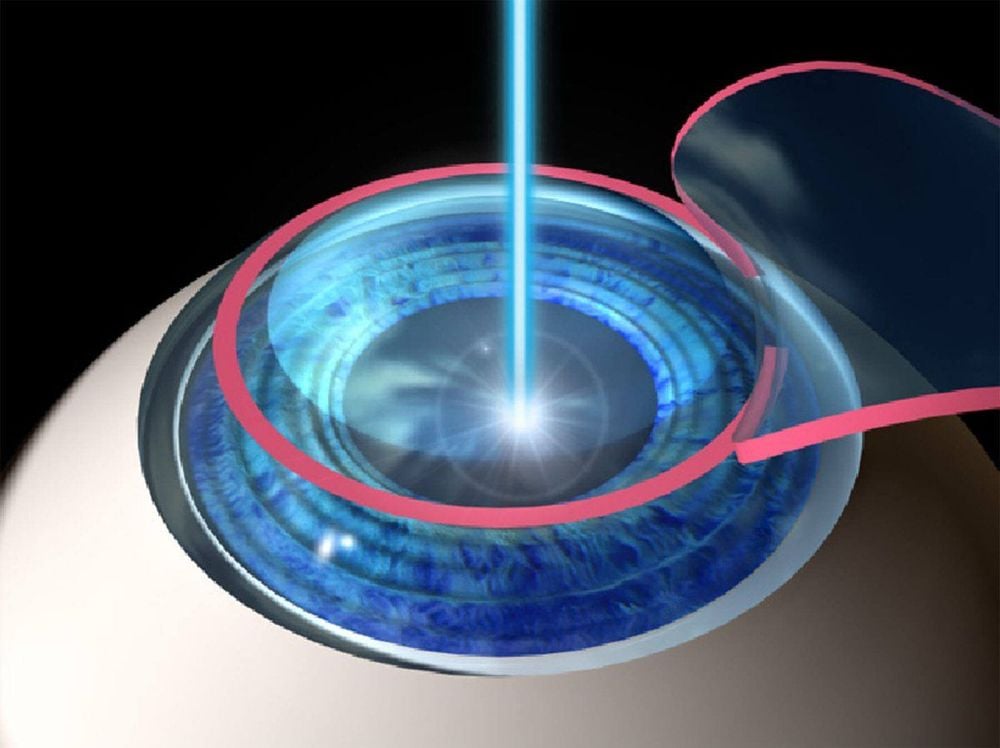
Phương pháp LASIK ứng dụng trong phẫu thuật khúc xạ
5. Some home remedies for nearsightedness
You cannot prevent myopia at this point, but you may be able to slow its progression. Here are some home remedies to help you correct nearsightedness, including:Get your eyes checked: Get your eyes checked regularly even if your eyes are fine. Manage chronic conditions: Some chronic conditions, such as diabetes and high blood pressure, can affect your vision if you don't get the right treatment. Protect your eyes from the sun: Wear sunglasses that block ultraviolet (UV) rays. Prevent eye injuries: Wear protective eyewear when doing certain things, such as playing sports, mowing the lawn, painting, or using other products with toxic fumes. Eat healthy foods: Try to eat more green vegetables, other vegetables and fruits. And studies show that certain foods are good for the eyes, such as fish high in omega-3 fatty acids, including tuna and salmon.

Sử dụng thực phẩm có lợi cho mắt giúp người cận thị khắc phục tình trạng bệnh lý
Don't smoke: Smoking has negative effects on health, including bad effects on the health of the eyes. Use the right corrective lenses: The right lenses help optimize your vision. Performing regular eye exams will ensure that the prescription you are prescribed is correct. Some studies show that wearing the wrong prescription glasses can increase the development of nearsightedness. Get enough light: You need enough light to see better. Reduce eye strain: Apply the 20-20-20 rule when using a computer or reading for long periods of time - every 20 minutes of work, your eyes need to rest for 20 seconds and see a distance of 20 feet . See your doctor right away if you experience any of the following symptoms: Sudden loss of vision in one eye (with or without eye pain); sudden blurred vision; double vision; or you see flashes, dark spots, or halos around lights. This could be a sign that you have a serious eye problem. Doctor CKI Nguyen Thi Bich Nhi has nearly 10 years of experience in the field of ophthalmology. Treatment of medical eye diseases as well as eye surgery such as: pterygium, entropion, milia, glaucoma and cataract surgery by Phaco method. Besides, it also treats diabetic retinopathy by intraocular Anti-VEGF injection and ophthalmic surgery. Currently, the doctor is an Eye Doctor in the Department of Medical Examination - Internal Medicine, Vinmec Nha Trang International General Hospital.
If there is a need for consultation and examination at the Hospitals of the National Health System, please book an appointment on the website to be served.
Articles refer to sources: mayoclinic.org, webmd.com




